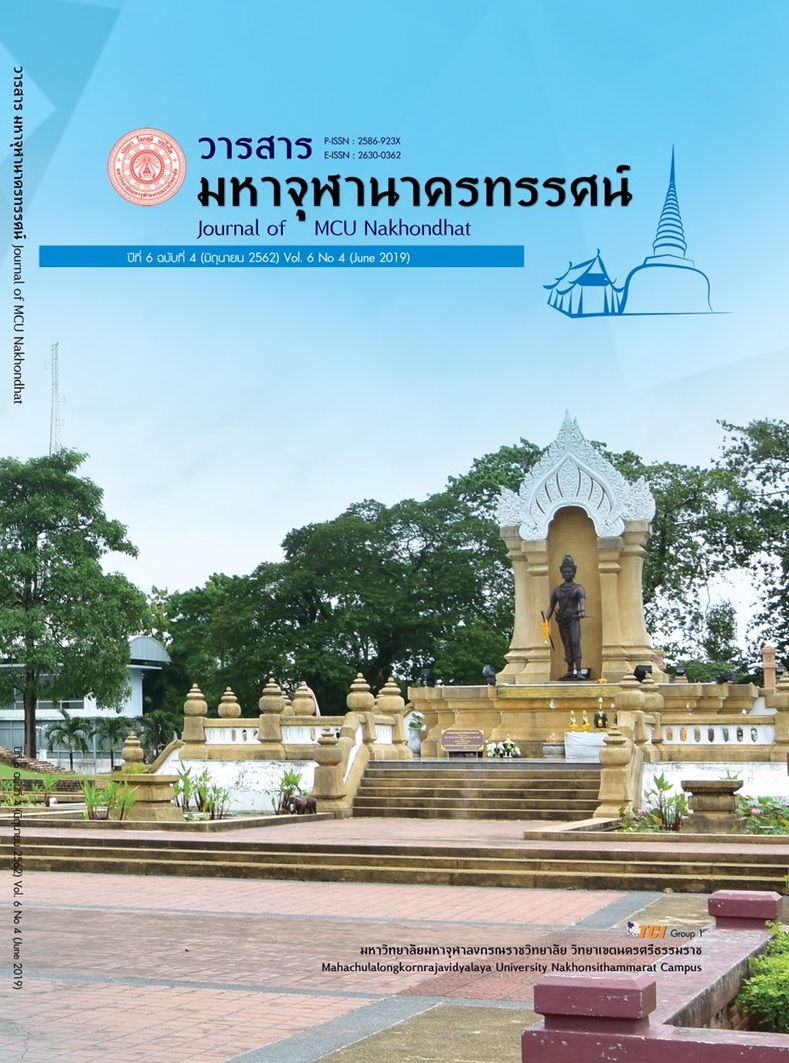THE CIVIL SOCIETY SELF – MANAGEMENT ENERGETIC IN THE TAPEE BASIN COMMUNITY IN SURAT THANI PROVINCE
Main Article Content
Abstract
Objectives of this research were to: (1) study of participation in self-management of the Tapee River Basin community (2) promote self-management network of the Tapee River Basin community (3) analyze of civil society dynamics, self-management, Tapee River Basin, Surat Thani Province. The qualitative research collected data from key informants with in-depth-interviewing and participants in focus group discussion and analyzed data by descriptive interpretation.
The results of the study showed that:
- Participation in self-management of the Tapee River Basin community was divided into three sides. In the area, it was found that the Tapee River Basin community shared spaces. They built a community tourism group office,a community road, a bridge to watch a market, see nature, and a community food center. The land was divided into a community shop area, and a community toilet. Facilities were found that Tapee River Basin Community provided homestay accommodation, recreational activities, OTOP product shop service and provided products for One Tambon One Product. Environment was found that the Tapee River Basin community had security guards. There were tour guides arranged officers and created rules.
- Promotion of self-management network of the Tapee River Basin community was divided into 2 areas, namely the search for value and identity of art in each community. It was found that the value and identity of art in each community was natural mangrove forest, local fishing lifestyle, and OTOP products from communities. Promoting further development to create value wad showed that promoting the self-management network of the community had to create a natural route tourism program and arrange tourism activities within the community and connect within other community networks.
3. Analysis of civil society dynamics, self-management, Tapee River Basin was found that the first aspect came from participation in self-management in both areas of facilities and environment. Second, promoting the network in self-management there was 3 aspects such as searching for value, the identity of art in each community, promotion of further development to create value, promoting conservation and linking the Tapee River Community Tourism Network.
Article Details
References
ธีรพัฒน์ อังศุชวาล. (2559). ปุจฉาว่าด้วย "ประชาคม" (cicil society): บทสำรวจทฤษฎีและแนวคิดจากต่างประเทศสู่การพิจารณาประชาสังคมเชิงปฏิบัติการและองค์กรพัฒนาเอกชนไทย. วารสารสำนักบัณฑิตอาสาสมัคร, 13(1), 9-11.
ปรีชา พันธุ์แน่น และคณะ. (2558). โครงการ การใช้ประวัติศาสตร์ชุมชนเป็นเครื่องมือในการสร้างพลังความร่วมมือของคนสายคลองบางบัว. รายงานวิจัย: สำนักงานกองทุนสนับสนุนการวิจัย (สกว.).
มัสลิน รัตนภูมิ. (2554). บทบาทของประชาสังคมในการพัฒนาท้องถิ่นในเขตเทศบาลตำบลปริก อำเภอสะเดา จังหวัดสงขลา. รายงานการวิจัย: บัณฑิตวิทยาลัย มหาวิทยาลัยสงขลานครินทร์.
ยนตรการ จินะคำปา และ ศิวรักษ์ ศิวารมย์. (2560). กระบวนการพัฒนาต้นแบบชุมชนบริหารจัดการตนเอง: กรณีของตำบลชมภู อำเภอสารภี จังหวัดเชียงใหม่. วารสารบัณฑิตวิจัย, 8(1), 183-197.
วลัยพร สุพรรณและคณะ. (2558). การรื้อฟื้นศิลปะการทอผ้าไหมสันกำแพง เพื่อสืบทอดวัฒนธรรมด้วยสืบพื้นบ้านและเสริมสร้างความเข้มแข็งของชุมชนตำบลสันกำแพง. รายงานวิจัย: สำนักงานกองทุนสนับสนุนการวิจัย (สกว.).
อัจฉรา ศรีลาชัย และภูเกริก บัวสอน. (2561). แนวทางการจัดการรูปแบบการท่องเที่ยวโดยชุมชนอย่างยั่งยืน กรณีศึกษา ชุมชนบ้านโคกเมือง ตำบลจรเข้มาก อำเภอประโคนชัย จังหวัดบุรีรัมย์. วารสารบัณฑิตศึกษา มหาวิทยาลัยราชภัฏวไลยอลงกรณ์ในพระบรมราชูปถัมภ์, 12(1), 218.


